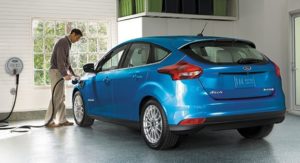
If you want a really powerful car, maybe one that can accelerate from 0 to 60 mph in less than 3 seconds, consider an electric vehicle like the NIO EP9.
You’re right, that’s too powerful. The NIO EP9 would also cost you more than a million dollars. But even more modest versions offer a respectable kick. The Chevy Bolt and Ford Focus, with price tags in the $35,000 range, make the jump to 60 mph in 6 to 11 seconds, which is about average for all U.S. cars. There’s a built-in-reason electric cars hold their own in performance, says Brian Sloboda, a program and product manager at the National Rural Electric Cooperative Association (NRECA).
“In an electric car, all of the power is going into the wheels. With a gas-powered car, a lot of power is lost inside the mechanical engine,” says Sloboda. “If you sit in an electric car and the driver smashes down on the accelerator, you are going to be thrown into the back of your seat, much more so than many gasoline cars.”
But wait, there’s more
“The battery is at the bottom of the car, so you have a lower center of gravity, which means you can take the corners crisper,” says Sloboda. “If you do a lot of driving in the hills or mountains, they are fun.” In March, Goodyear announced a new tire that would hold up better under the “instant torque from electric motors.”
Electric vehicles hold a lot of other surprises compared to the traditional view of them as a glorified golf car. Even electric co-ops in rural parts of the country are hearing interest from their members.
About 700,000 electric vehicles drive on U.S. roads today, according to an analysis by CoBank, a financier for electric co-ops. That number could jump to 3 million in the next five years, says CoBank. The U.S. Department of Energy’s Energy Information Administration projects electric vehicle sales growing from about 1 percent of the market today to 12 percent by 2055.
Car makers are pushing those trends. In October 2017, General Motors said it would launch 20 new electric vehicles by 2023. In January, Ford announced plans to invest $11 billion in a lineup of 40 hybrid and electric vehicles by 2022. Volkswagen said it had secured $25 billion in electric car batteries and technology and plans to scale that up to $60 billion.
One of the most radical new notions about electric vehicles, advises Sloboda, is to think of them not as cars or trucks, but as consumer electronics.
“The internal combustion engine is a perfected technology, so those cars aren’t improving at a very rapid pace,” says Sloboda. “But electric vehicles are evolving at a very rapid pace, so you’re really kind of comparing it to a cellphone or a computer.”
What that means for consumers, says Sloboda, is that they might consider leasing an electric car rather than buying one, to make it easier to trade in the car to take advantage of the annual improvements in battery life and other features.
Other unexpected benefits of electric vehicles that could speed their acceptance, says Sloboda, include range, maintenance, and more competitive costs.
Will I run out of juice?
The electric vehicle industry has a term for the biggest roadblock to its growth – range anxiety. But Sloboda says the fear of getting stranded far from home with no way to refuel may be overblown, and getting less concerning.
“The range on the electric cars you can buy today is perfectly sufficient to cover almost everyone’s daily commute,” he says. Sloboda says that while electric cars won’t work for someone regularly commuting 100 miles a day, “For most people, even in rural areas, that number is under 40 miles a day. Most electric cars on the market today have between a 120-mile range, and some of them are getting close to 200 miles.”
The Federal Highway Administration reports the average American drives 37 miles a day.
Less hassle
Electric car acceptance doesn’t need to wait for a network or charging stations to appear around the country, says Sloboda. He sees refueling more like this: you plug your car into an outlet in your garage at the end of each day, and by morning it’s fully charged.
“No more having to stop and fill your tank up once or twice a week,” he says. “You can charge it at home while you’re sleeping and wake up to a full tank every single day.”
Electric cars can also save on maintenance, say Sloboda. “With an electric vehicle, you don’t have oil changes, and you don’t really have transmission fluid changes,” he says.
And regenerative braking in electric cars uses the electric motor to slow the car rather than relying only on brake pad friction, Sloboda says, “A lot of electric vehicle owners are saying they’ve never replaced their brakes because you just don’t have the physical wear and tear on the brake pad.”
Costs are coming down
Sloboda says electric car costs today make them a luxury car, but that’s changing. As electric car research, development and production increases, costs will be coming down. Tax breaks for electric cars at the federal level and in some states can reduce costs by several thousand dollars. And Sloboda notes that electricity costs less per mile than gasoline.
But one of the main reasons drivers buy electric cars is for the environment. Sloboda says an electric car “is cleaner than a gas-powered car, no doubt about it.”
Another advantage of an electric car, he adds, is that “you’re powering it with electricity from your electric co-op.”
Paul Wesslund writes on cooperative issues for the National Rural Electric Cooperative Association, the Arlington Va.-based service arm of the nation’s 900-plus consumer-owned, not-for-profit electric cooperatives.
Electric vehicles aren’t just for city driving
Check our the whole story in the November issue of MCPA NEWS. What you don’t know about electric cars could THRILL YOU!
